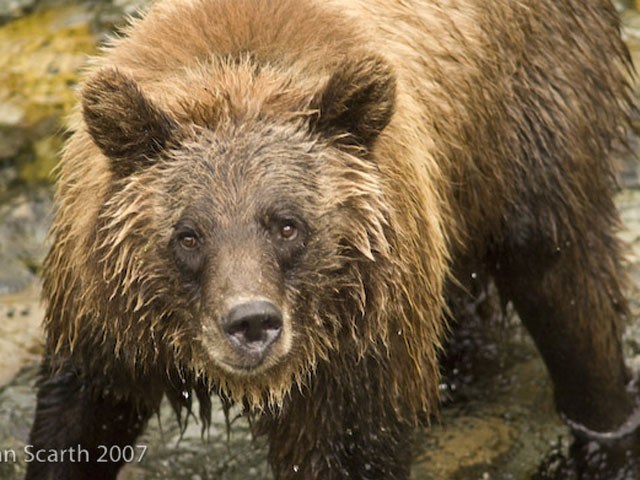By John Scarth
Bears are a familiar sight to most Whistler residents. They probably have made a mess if you left any garbage outdoors, and might even have entered your home. This happened to me once, and knowing I was sleeping behind the next door to be pushed open if the bear was still curious, I was definitely not enjoying being that close!
However, photographing wildlife is something that has always interested me, so when a friend told me about the bears of Hyder, Alaska and that it’s a safe and relatively easy way to view grizzly bears, I was sold.
The trip brought us north from Whistler, over the Duffey Lake Road and up towards Prince George. From there we headed west up through Smithers and to the Junction of Kitwanga. This is where you either head north to Alaska or towards the coast and Prince Rupert. Our destination was north to Stewart, B.C., where a friend owns and operates the Stewart Mountain Lodge. Stewart is a port town, at the head of the Portland Canal, with heavy ties to mining and logging and it has seen its share of ups and downs.
Once settled, we familiarized ourselves with the local watering hole in preparation to go bear viewing the next morning. Hyder is less than five minutes outside of Stewart and welcomes you with a western-style main street, with shops reminiscent of a gold rush era.
The bear viewing area is located three miles north of Hyder on the Salmon River Road, at a creek named very simply, Fish Creek. The creek hosts chum and pink salmon runs from early July through September. The elevated deck of the platform runs over 100 metres down the creek, and is backed on one side by a small lagoon. This is where we were to spend most of the days over the next week. Photographers and wildlife enthusiasts flock to this area every summer, due to the fact it is the only place to view grizzlies without boarding a float plane or boat. For a seven day pass, I paid only $20, which would have worked out to about 25 cents a bear.
Both grizzly and black bears are common in the area, but the grizzlies definitely run the place. The Latin name for a grizzly, Ursus Horribilus, doesn’t do much for the stigma attached to them. It’s easy to understand why they got the name when you see one standing over seven feet tall and weighing 700 pounds.
In the time spent at the platform we were able to see about five or six bears regularly, with some new faces every once in a while.
One group that was regular to the creek was a mother with her three cubs. This was usually a highlight, because the cubs would put on a show that had all the cameras firing. If any male bear or boar entered the creek when the mother was around the show quickly ended and the cubs would run off to avoid a confrontation. The bears are most active in the early morning and late evening, when the temperature is more comfortable. However we were able to watch a few go for a swim in the lagoon to cool off midday.
With all the money spent on the Fish Creek platform, and the obvious return from paying tourists, it’s sad that the community still burns its garbage at the dump. You’d think putting up a fence or installing an incinerator would be a priority, but upon visiting the dump we witnessed a group of bears eating and rummaging through burning garbage. If you get close enough you can see the burnt hair and patches left by the fires.
Because of their size, the grizzlies don’t have to feed at the dump. But the black bears are forced to get what they can, and we saw many at the dump each time we stopped. If you speak to the locals they agree it’s not the best situation, but they know what will happen if the proper steps are taken. When Stewart put in a fence around its dump more than 100 bears were destroyed for venturing closer into town for food.
With all this bear activity it’s hard to believe there is only one incident on record in the area. The chef at the Sealaska Inn, a bar and restaurant in Hyder, fell asleep, or perhaps passed out, on the picnic table outside the bar. Since he had worked a full shift cooking seafood and other dishes, his scent attracted a grizzly. The cause of death was confirmed as a mauling by a grizzly bear.
While bears may bring people to the area in the summer, they are just one of many interesting sights and activities. The Salmon Glacier, about 40 minutes from Stewart, is the largest glacier in the world accessible by road. Just a few kilometres further is the Granduc Mine. There, 26 men lost their lives on Feb. 18, 1965 in one of the worst avalanches in Canadian history.
With all the salmon runs in the area fishing is also a big draw. Meziadin Lake just outside of town plays host to amazing fishing and also has one of the highest concentrations of grizzlies in Canada. If lakes aren’t for you a quick trip down to the town dock can offer up an easy Dungeness Crab dinner after an hour or two. You might like a trip down the Portland Canal, the fourth longest fjord in the world, where you could also catch some halibut and if you’re lucky a king crab.
Summer or winter a trip north to Stewart, B.C. and Hyder, Alaska is definitely one to remember. Look up Dave and Christy at Stewart Mountain Lodge at www.stewartmountainlodge.com.




